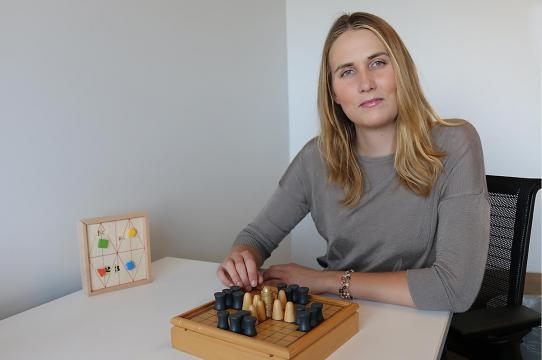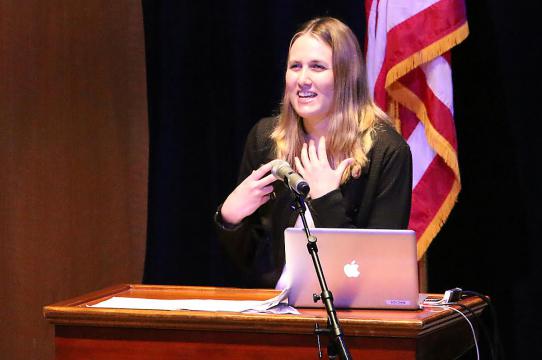Elizabeth Swensen’s expertise at producing innovative digital games propelled her career from studying the past to creating the future. With her love of Latin and the classics in high school, she seemed destined to focus on the ancient classics, but a few surprise turn of events in her life changed that direction.
Now, as Assistant Professor of Art and Design: Games and Playable Media, who has recently jointed the Arts Division at UC Santa Cruz, she is well on her way to being one of the most eminent game designers in the industry, which is particularly notable considering how male-dominated the field has been.
Forbes Magazine “30 Under 30”
Along the way, Swensen has been a game designer and research associate at the Game Innovation Lab in the University of Southern California’s (USC) School of Cinematic Arts, and showcased her work at the prestigious IndieCade Festival and Games for Change. In 2012, Forbes Magazine spotlighted her as one of the “30 Under 30” featuring “the brightest young entrepreneurs, breakout talents and change agents”.

“There weren’t very many undergraduate degrees that you could get in games when I went to college,” says Swensen. “And there weren’t a lot of women in the industry, so there were very few role models.” But while studying archeology in Rome, she met up with a friend of hers who was attending the film program at USC and, knowing how much she loved games, asked why she wasn’t focused on studying them.
“USC had just started a games program and my friend’s push actually lead me to getting my graduate degree in games there,” she says. Prior to that, Swensen had earned her BA in Classics at Willamette University in Salem, Oregon and was planning to eventually acquire her Ph.D. in Classics and teach high-school level Latin.
"My Parents Were Very Skeptical of Video Games"
She had always loved playing a wide variety of games, especially video games. “I played a lot of games growing up, but when I was around seven years old, my father introduced me to old-school adventure games,” she says. “However, my parents were very skeptical of video games. And, like many parents, they didn’t want their kids spending too much time in front of screens.”
At the age of nine, wanting desperately to get a new video game console, Swensen shrewdly offered to forgo her $2 a week allowance in favor getting the money all at once at the end of the year so she’d have enough funds to buy one. “I proved that I could still get good grades and so eventually I won my parents over! They’re extremely proud of me now, knowing that all of that gaming time actually went somewhere,” she smiles.

Growing up as an only child, Swensen became fast friends with most of the kids on her block who also like to play video games. “We were so conniving,” she says. “My house and my friends’ were all right next to door to each other, and we all had various video systems. We’d spend Saturdays playing video games and when our parents would tell us to stop and play outside, we’d just go to the next house and keep playing until we got kicked out…we just kept rotating through houses!”
Video games were Swensen’s passion but she also got a solid foundation in how games work by playing a lot of traditional board and table-top games, which enabled her to think more about the actual mechanics behind games.
Master Thesis Game Became a Finalist at IndieCade
After being admitted to join the Interactive Media MFA program at USC, she started creating her own games, with her Master’s thesis being a game she made called The Witch, a narrative game for tablets where the player is a young girl labeled as “a witch” and the player determines how she is viewed depending on the language that’s said by other characters, ultimately shaping how her story is told. The innovative game became a finalist in the 2011 IndieCade festival.
“I’m really interested in the way we can explore different forms of emotional expression through play,” she says. “A lot of my teaching pedagogy is around that area and I think it aligns well with Robin’s [Hunicke] goals. Some of my favorite assignments when I was teaching at USC were around designing mechanics towards emotions we don’t typically see associated with games.”
One assignment that particularly stands out for her was where students were asked to write about a strong emotion they felt when they experienced another form of media – a book, music – anything but a game. They then had to sum that up in only a couple of words, and then design a physical (not a digital) game around those words.
Creating Games with Emotion
“The students typically would write things down like ‘nostalgia’, or ‘euphoria’, or ‘depression’ and they would have to start thinking about what actions they, as the game designer, would allow the player to take to start feeling those emotions,” explains Swensen. “But they also had to feel it in way that didn’t feel manipulative or exploitative. That’s what made it such an extremely difficult assignment. It was really a turning point for many of my students in understanding their own design process.”

Swensen also has been researching how games and learning can intersect and be used in a learning context. She did a research project at the Games Innovation Lab that was a digitally moderated card game about historiography, specifically looking at the causes of World War I. “The point of this game is to not only learn about World War I, but to understand how we dissect history.”
Another project of hers was designed to assist underserved high school students understand how to successfully apply for college. Called Mission: Admission, it was made available as a Facebook game. Last year, the game was translated onto mobile and Web for a larger, longitudinal study with the Department of Education, as a part of the First in the World program. The results will be ready in two years and will be tracking students’ who are using the game and their success in applying to and attending college.
“Being Collaborative Is Very Necessary"
When advising students, Swensen encourages them to take classes in both coding and art. “That cross pollination is important because, even if you’re not going to be a software engineer, you’ll still have to communicate with software engineers if you want to work in games. And if you don’t want to be a game designer, you’ll still have to communicate with the design team. So, I recommend that students discover their interests and then find the coursework that fits those passions.”

She also stresses the importance of collaboration. “Being collaborative is very necessary and the [Art Division’s Games and Playable Media] program teaches that, especially for anyone who wants to join a game company.”
"I Love UCSC’s Commitment to Both Research and Teaching"
Still discovering the Santa Cruz area, Swensen enjoys the outdoors, walking around the campus and taking long walks to the beaches. And, of course, checking out the games and hobby stores downtown. “My other passion besides games is cooking,” she says. “The Farmers’ Markets here are phenomenal!”
As she settles in, she’s really looking forward to teaching. “It’s very exciting and beautiful here,” she says. “I loved working for USC…it took a great opportunity for me to leave there. But one of the things that drew me to UC Santa Cruz is the excitement of being part of a new program and helping shape its voice. I also love UCSC’s commitment to both research and teaching, and the opportunities to expand my teaching experience in addition to continuing my own research.”
All photos by Julie Rogge
Originally posted: 01/31/2017


